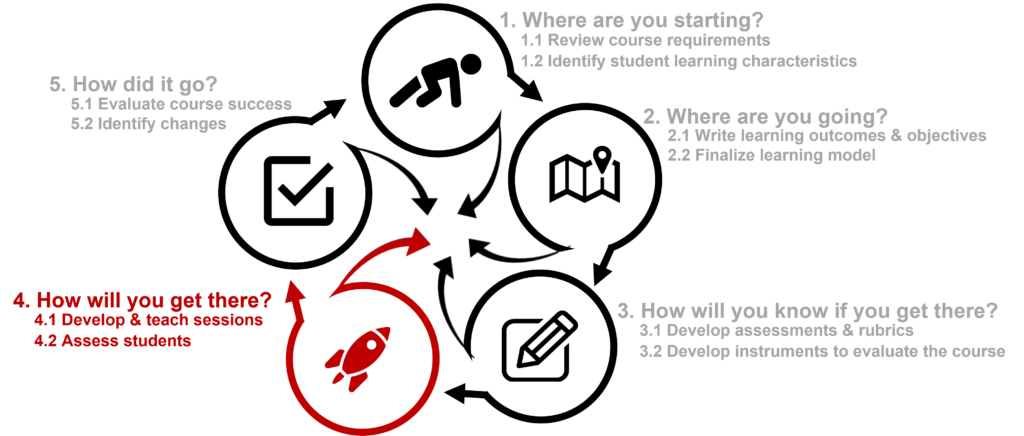Unit W – The IDI Workbook
Step 4: How Will You Get There?
4.2 Assess Students

Before you start teaching, you will finalize activities and create all needed materials for class. At the end of the class, you can take brief notes on how it all went.
This step in IDI is where you develop your class outlines (lesson plans), then teach and assess the students’ progress.
4.2 Results (What)
- Analysis of how well students are progressing.
- Remedial actions needed to support student learning.
- Feedback to students.
4.2 Overview (Why)
As the term progresses, you use your assessment plan, providing feedback and providing progress toward the final grade.
Feedback has been found to be one of the most impactful methods of supporting student growth. Use the rubrics and/or feedback form to provide specific feedback to each student.
4.2 Suggestions/Instructions (How & What If)
The following suggestions are grouped into the following:
- General
- Feedback
General
- Use formative assessments and effective feedback techniques to support student growth and motivation. (B5, C6T)
- Use assessments to determine student progress and identify if you need changes in your content and/or methods (Hattie, 2011). (B2)
- Tell students when you will have completed reviewing their assessments (Chickering & Gamson, 1987; Hattie, 2011, pp. 137). (B2, C7)
Feedback
- Provide feedback and support on both a cognitive and emotional level. (A7, C7)
- Use Hattie’s feedback model to affirm what they did well, and to correct and direct. (A4, B2, C7)
- Coach students to critique their own efforts. (C7)
- Consider adding contact information to the feedback for every assessment to remind students how they can get further support (Chickering & Gamson, 1987). (B2, C7)
- “Offer clear and specific feedback on assignments and encourage resubmission of assignments” (Online Education and Training, California State University system, n.d.). (B3)
- Consider one-on-one feedback or provide a recording of your comments and feedback. (B3)
- Focus on student strengths rather than weaknesses (TEAM-UP, 2020, p. 48). (B3)
- Reflect on your feedback methods and types to ensure that you are providing constructive, unbiased, and effective feedback (Sheridan Center for Teaching and Learning, 2020; TEAM-UP, 2020, p. 48). (B3, A10)
- Use the pre-developed feedback and the feedback form to provide appropriate feedback on all assessed work. (Chickering & Gamson, 1987; Graesser, 2010, p. 20; Hattie, 2011, p. 137). (A1, B1, B2, B5, C7)
- If you use a discussion rubric, share the results for each student early and frequently to emphasize the importance of participation. (C6D, C7)
4.2 Worksheets
4.2. Assignment Feedback Form
Use this to investigate possible pedagogical aspects of your course.
View this page (W4.2 Details) as .pdf (opens in new tab)
Go to W4.2 Worksheets (Word doc opens in new tab)
Link to other areas:
4.2 References
Chickering, A. W., & Gamson, Z. F. (1987). Seven Principles for Good Practice in Undergraduate Education. AAHE Bulletin. https://eric.ed.gov/?id=ED282491.
Graesser, A. C. (2010). Scientific Bases of Adult Learning. 2010 APA Education Leadership Conference, Washington DC. https://www.apa.org/ed/governance/elc/2010/media.
Hattie, J. (2011). Which strategies best enhance teaching and learning in higher education? In Empirical research in teaching and learning: Contributions from social psychology. (pp. 130–142). Wiley-Blackwell. https://doi.org/10.1002/9781444395341.ch8.
Online Education and Training, California State University system. (n.d.). Nine Common Elements of Universal Design for Learning in Higher Education. California State University, Fullerton. http://oet.fullerton.edu/accessibility/Nine_Common_UDL_Elements_2-10-12.pdf.
Sheridan Center for Teaching and Learning. (2020). Effective Teaching Is Anti-Racist Teaching. Sheridan Center for Teaching and Learning, Brown University, 1812. https://www.brown.edu/sheridan/teaching-learning-resources/inclusive-teaching/effective-teaching-anti-racist-teaching.
TEAM-UP. (2020). The Time Is Now: Systemic Changes to Increase African Americans with Bachelor’s Degrees in Physics and Astronomy (No. 978-1-7343469-0–9; Team-Up, p. 186). American Institute of Physics. https://www.aip.org/diversity-initiatives/team-up-task-force.
